| New York
Architecture Images-Greenwich Village
Church of the Ascension (Episc.) |
||||||||||||||||||||||||||||||
|
architect |
1841
Richard M. Upjohn altered 1889 McKim, Mead and White |
|||||||||||||||||||||||||||||
|
location |
Fifth Ave. at West 10th St | |||||||||||||||||||||||||||||
|
date |
1841 | |||||||||||||||||||||||||||||
|
style |
Gothic | |||||||||||||||||||||||||||||
|
construction |
Brownstone | |||||||||||||||||||||||||||||
|
type |
Church | |||||||||||||||||||||||||||||
|
|
||||||||||||||||||||||||||||||
|
images |
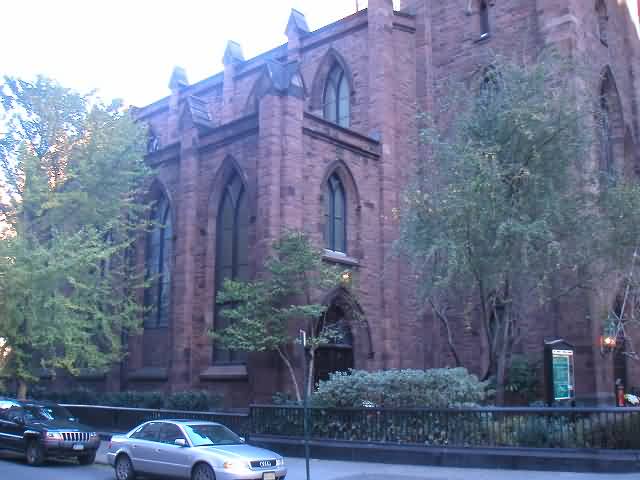 |
|||||||||||||||||||||||||||||
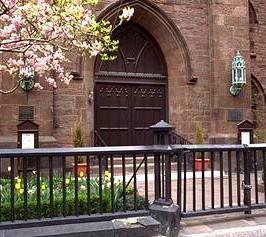 |
||||||||||||||||||||||||||||||
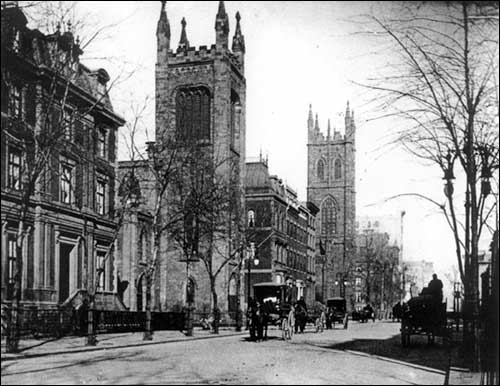
|
||||||||||||||||||||||||||||||
| Fifth Avenue looking north from E. 10th Street, Church of the Ascension foreground, First Presbyterian Church further up (about 1900). | ||||||||||||||||||||||||||||||
| The first church (1841) built on Fifth Avenue, original design by Richard Upjohn; tower modeled on that of Magdalen College, Oxford, England by architect Joseph Wells. As Edith Lewis notes, Cather loved its "altar with John LaFarge's great fresco above." In Cather's short story, "The Diamond Mine," diva Cressida Garnet's plans include doing over her "Tenth Street house" and being "married in the Church of the Ascension | ||||||||||||||||||||||||||||||
The History of the
|
||||||||||||||||||||||||||||||
| Rectors of the Parish | ||
| 1827-1842 | The Rt. Rev. Manton Eastburn | |
| 1843-1859 | The Rt. Rev. Gregory Thurston Bedell | |
| 1859-1882 | The Rev. Dr. John Cotton Smith | |
| 1882-1892 | The Rev. Dr. E. Winchester Donald | |
| 1893-1924 | The Rev. Dr. Percy Stickney Grant | |
| 1925-1945 | The Rt. Rev. Donald Bradshaw Aldrich | |
| 1945-1953 | The Rev. Dr. Rosco Thornton Foust | |
| 1955-1964 | The Rev. Dr. James William Kennedy | |
| 1964-1971 | The Rt. Rev. John McGill Krumm | |
| 1972-1997 | The Rev. Donald R. Goodness, Jr. | |
| 1999 - | The Rev. Andrew W. Foster III | |
|
|
||
| The title "Rt. Rev." connotes those former rectors who later became bishops in the Episcopal Church | ||
After serving for fifteen years as rector, Manton Eastburn was chosen to become the Assistant Bishop of Massachusetts. (The Church of the Ascension has had only 11 rectors in its 170 years, four of whom became bishops.)
From its earliest days, the church has been the setting for many notable events, including the marriage of President John Tyler and Julia Gardiner in 1844. Many such prominent New Yorkers as August Belmont, William B. Astor, Frederick de Peyster and William C. Rhinelander have been parishioners.
Remarkable demonstrations of social concern appeared early in the church. Between 1843 and 1859 the sum of $225,000 was donated for purposes outside the parish, when the regular budget in any given year was no more than $10,000, the bulk of which came from pew rents. During this period, for example, Aspinwall Hall was given to the Virginia Theological Seminary; over $3,000 was contributed to relieve famine distress in Ireland; funds to build Ascension Hall were given to Kenyon College in Ohio; a fund was raised to help struggling churches in places as far afield as Liberia and Frankfort, Kentucky; and in New York, the Church of the Ascension was instrumental in establishing and maintaining the Five Points Day School, which sought to feed, clothe, and educate the children of one of the city's worst neighborhoods of crime, poverty, and degradation.
In 1888 the women of the parish set up the St. Agnes Nursery, the first day nursery in New York City. Here the babies and young children of working mothers found shelter and protection. Like many vital and financially viable parishes, Ascension established several missions and chapels in New York, maintaining them for as long as they filled a need.
The fourth rector, the Reverend E. Winchester Donald, was a friend of many of the artists dwelling in the church's Greenwich Village neighborhood. He was convinced that beauty, which elevates the human spirit, is an appropriate setting for worship. A generous gift from the Misses Julia and Serena Rhinelander made it possible for John La Farge, Stanford White, and David Maitland Armstrong to transform the chancel from a bleak, bare space into a composition of the highest order. Surmounted by La Farge's great mural, The Ascension of Our Lord, the chancel is today one of the most beautiful spaces in New York.
When the Reverend Percy Stickney Grant was called as rector in 1893, he said he would accept only on the condition that Ascension be made a parish of free pews. This was a radical step for an Episcopal parish to take at that time, giving up the fancied security of pew rents and depending on voluntary giving, but the Vestry acceded to his demand.
An equally radical departure was suggested by the sixth rector, the Reverend Donald B. Aldrich, when he proposed to the Vestry that the church be kept open at all hours of the day and night. On November 9, 1929, barely a week after the stock market crash, the central doors were opened, not to be locked again until October 1966, when a more lawless social climate made limited hours necessary. (The church is at present open weekdays from noon to 1 p.m. for prayer and meditation and at 6 p.m. for Eucharist, as well as open for its other services.) Ascension was the first church in New York City to keep its doors open at all hours, and during the Depression homeless men slept in the pews.
The tenth rector, the Reverend Donald R. Goodness, retired in 1997, after serving in this parish for twenty-five years. During the quarter century he spent with Ascension, Father Goodness embraced a number of changes, both at Ascension and in the Episcopal Church at large. It was during Donald Goodness's rectorship that the celebration of the Eucharist became the main service each Sunday instead of once a month. His tenure saw the introduction of eucharistic vestments and a more ceremonial liturgical approach in general. When the 1979 prayer book was introduced, he embraced its multiple rites and the church continues today to celebrate the Eucharist using all six forms found in the Book of Common Prayer.
The eleventh rector of Ascension, the Reverend Andrew W. Foster III, came to serve the parish in 1999, after serving as rector of St. Paul's Church on Nantucket Island, Massachusetts, and earlier as the Episcopal chaplain at the University of Michigan and then as chaplain at Kenyon College. Since his investiture as Rector, the parish has seen some updates to its liturgy in keeping with common practice throughout the Episcopal Church, and it now enjoys a regular schedule of services of prayer and music especially for college students each Sunday during the school year at 5pm.
Despite its many changes since 1827, the Church of the Ascension remains a place of vibrant worship, beautiful music, active service, and quiet contemplation, its members striving to seek and serve Christ in all persons. The congregation, clergy and staff of Ascension invite you to join us for worship and fellowship any Sunday morning in New York City, now as then at Fifth Avenue and Tenth Street in historic Greenwich Village.

 The Church of the Ascension in the City of New
York was founded in 1827. Its first church building, on Canal Street
just east of Broadway, was consecrated in 1829 and burned to the ground
in 1839.
The Church of the Ascension in the City of New
York was founded in 1827. Its first church building, on Canal Street
just east of Broadway, was consecrated in 1829 and burned to the ground
in 1839.
The present edifice at Fifth Avenue and Tenth Street, the first church on Fifth Avenue, is one of the earliest churches designed by the English-born architect Richard Upjohn (1820-1878), who was working on plans for Trinity Church, Wall Street, at the same time. The cornerstone was laid in 1840 and the church was consecrated on November 5, 1841.
During the years 1885-1889, the interior of the church was remodeled. Galleries on the north and south were removed. The chancel was decorated as we see it today, a memorial to William C. Rhinelander and Mary Rogers, his wife, given by their daughters. The work was done by McKim, Mead and White under the general direction of Stanford White (1853-1906).
The sculptured angels over the main altar are the work of Louis St. Gaudens (1854-1913).
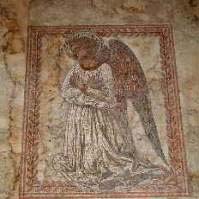
The main altar and the two angels in the mosaic were done by D. Maitland Armstrong.
The painting of "The Ascension of Our Lord" above the main altar is the work of John La Farge (1835-1910). It was executed on canvas in place and completed in 1888. It stands in the first rank of modern mural decoration in America. John La Farge also designed four of the stained glass windows (described below).
The freestanding altar, given in 1983 by Esther D. Hamilton in memory of Catherine B. Fair, was designed by a Polish-born architect, Andrej Ryczek, and made by Lewis Epstein and Alex Tweedie, woodworkers from Boston.
The Holtkamp organ, a superb recital instrument, was installed in 1967. It has 4,500 pipes, 67 stops, and 81 ranks distributed among the pedal, great, swell, positiv, and solo divisions. Eclectic in conception, the organ is adapted to the needs of organ literature of all periods. Its tonal quality is greatly enhanced by the excellent acoustics of the church building.
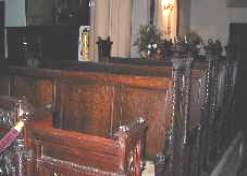
The choir stalls, designed by McKim, Mead
and White, were made by the J.&R. Lamb Studios. They were given in 1885
by Euphrasia Leland and Emma Leland Wesson in memory of their sisters,
Louisa Leland Limbert and Adelaide Leland.
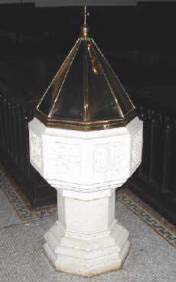
The baptismal font, given by the St. Agnes Society in 1891, was cleaned and repaired in 1983, when a new brass cover was designed and made by Rambusch Studios.
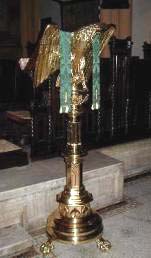
The eagle lectern is a memorial to the Rt. Rev. Gregory Thurston Bedell, second rector of the parish, and was given by his former parishioners in 1898.
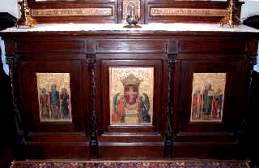
The three panels on the front of the side altar were designed by Helen Maitland Armstrong in 1930. The wood used was taken from the sedilia formerly placed there in memory of Francis and Euphrasia Aguilar Leland.
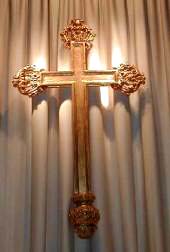
The cross above the side altar was brought from Italy and is a memorial of Earl Hulbert Aldrich, given by the Rt. Rev. Donald Bradshaw Aldrich, D.D., sixth rector of the parish.
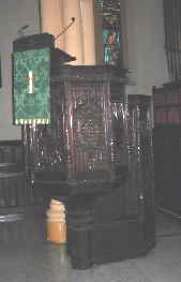
The pulpit, given by Meta Nielson in memory of the Rt. Rev. Manton Eastburn, first rector of the parish, was designed by Charles F. McKim and carved by Joseph Cabus in 1884.
Two paintings by Edwin H. Blashfield hang in the rear of the church. On the north aisle is “The Angel with the Flaming Sword,” which was painted in Paris in 1890-1891 and shown at the Salon of 1891 and at the Chicago World’s Fair of 1893. It was given by the artist and his wife, Grace Hall Blashfield, in 1935, in memory of the Rev. E. Winchester Donald and the Rev. Percy Stickney Grant. On the south aisle is “In the House of the Carpenter.” It was lent in 1939 and became the church’s property at the death of the artist’s widow in 1947.
(North side, from the Fifth Avenue end.)
1. The Weir memorial, J. Alden Weir (1852-1919), artist. Subject: “An Incident in the Flight into Egypt.” Given in memory of Anna Dwight Weir (1862-1892) and Julian Alden Weir (1888-1889).
2. The Reynolds Memorial, Joseph Lauber (1855-1948), artist. Subject: “Christ’s Admonition to Thomas.” Given in memory of James Van Beuren Reynolds and Frederick Henry Reynolds.
3. The Rhinelander Memorial, Frederick Wilson (1858-1938), artist. Subject: “The Women at the Sepulchre.” Given in 1894 in memory of Julia Rhinelander (deceased 1890). Design executed by Tiffany.
4. The Grosvenor Memorial, Frederic Crowninshield (1845-1918), artist. Subject: “Angels at the Sepulchre.” Given in memory of Jasper Grosvenor (1794-1857) and Matilda A. Grosvenor (deceased 1885).
5. The Davies Coxe Memorial, John La Farge, artist. Subject: “The Good Shepherd.” Given in 1910 in memory of Davies Coxe (1862-1908).
(South side, from the Fifth Avenue end.)
1. The Southworth Memorial, John La Farge, artist. Subject: “Mary Magdelene, Joanna, and Mary the Mother of James at the Sepulchre.” Given in 1890 in memory of Emily Martin Southworth (deceased 1888).
2. The Tailer Memorial, D. Maitland Armstrong (1836-1918), artist. Subject: “The Child Jesus Found by His Mother in the Temple.” Given in 1895 in memory of Robert W. Tailer, Jr.
3. The Leland Memorial, John La Farge, artist. Subject: “The Presentation of Christ in the Temple.” Given in memory of Francis Leland (1807-1885) and Euphrasia Aguilar, his wife (1816-1879).
4. The Neilson Memorial, D. Maitland Armstrong, artist. Subject: “The Annunciation.” Given in 1886 in memory of John Neilson (1799-1851) and Margareta, his wife (1807-1877).
5. The John Cotton Smith Memorial, John La Farge, artist. Subject: “Nicodemus Coming to Jesus by Night.” Given in 1886 in memory of the Rev. John Cotton Smith, D.D., third rector of the parish.
1. The Longstreth Memorial (north and south above the chancel), Henry Lee Willet (1899-1983), artist. Given by Mrs. N. Lucas Longstreth in 1963: two windows on the south side in memory of her parents, William E. and Jennie Pratt Lucas; two windows on the north side in memory of Harriet Baum. Design executed by Willet Stained Glass Studios.
2. The Lothrop Memorial (above the third bay arch on the south side), John Humphreys Johnston, artist. Subject: “The Vision of St. John.” Given in memory of Sarah Davis Lorthrop.
3. The Muhlenfels Memorial (above the fourth bay arch on the south side), Henry Lee Willet, artist. Given in memory of Alice Mary Muhlenfels in 1963. Design executed by Willet Stained Glass Studios.
4. The Goodness Memorial (above the fifth bay arch on the south side), Nancy Howell (born 1955), artist. Subject: “Let the Children Come to Me.” Given in memory of Donald Roy Goodness, Jr. (1954-1978) and dedicated in 1999. Design executed by the Gil Studio.
5. The Loomis Memorial (above the third bay arch on the north side), John Humphreys Johnston (1857-1941), artist. Subject: "The Two Marys at the Sepulchre."
6. The Sinaly Memorial (above the fourth bay arch on the north side), Colum Sharkey (born 1922), artist. Subject: “Consider the Lilies of the Field.” Given in 1989 by Marguerite W. Sinaly in memory of her parents, Adolf Stephen Sinaly and Caroline Pierce Oliver Sinaly, her brother Adolf Sinaly, her sister Lavinia Scott, and her brother-in-law Howard Scott. Designed and executed by Willet Stained Glass Studios.
1. The Jackson Memorial (south wall), D. Maitland Armstrong, artist. Given in 1911 in memory of Mary Louise Jackson by her husband, H.H. Jackson.
2. The Catherine B. Fair Memorial (north wall). Given in memory of Catherine B. Fair (deceased 1973) by Esther Hamilton. Design executed by Rohlf Studios.
Five windows consisting of 123 illustrations depicting incidents from the story of Creation to the story of Judas Maccabeus. They were given in 1941 by Susan Alfreda Cox in thanksgiving for the life and ministry of the Rt. Rev. Donald Bradshaw Aldrich, D.D., sixth rector of the parish (1925-1945). They were designed and executed by G. Owen Bonawit.

Given in memory of Mark Thomas Cox and Emily Maria Cox by their daughter, Susan Alfreda Cox, in 1933. The twelve bells, made in Loughborough, England, range from middle C to the second E above the diatonic scale of C, also the raised fourth and flat seventh (F# and B-flat). The memorial tablet in the vestibule for the tower bells was designed by Ruth Brooks.
In 1957, the Municipal Art Society and the New York Chapter of the Society of Architectural Historians named the Church of the Ascension as nationally important and worthy of preservation because of its architectural value, sculpture, stained glass, and painting. In 1988, the church was declared a National Historic Landmark by the U.S. Secretary of the Interior.
How full was
the building?
About one-third full. But remember that this was a mid-week worship – not
the regular Sunday morning worship.
Did anyone welcome
you personally?
As we arrived at the door, the rector was warmly greeting the arriving
worshippers with a welcome, a smile, and a handshake. Quite unlike many
places' welcomes. All the while the tower bells were pealing their
welcome. As we listened through the open door, we could hear the organ
voluntary in the distance.
Was your pew
comfortable?
It was a box pew, comfortable and the kneelers were adequate. An usher
seated us, handed us the order of service, and closed the door of the
pew.
How would you
describe the pre-service atmosphere?
The congregation was enraptured by the organist's playing of the Durufle
Variations on "Veni Creator". They also remained in their pews for the
voluntary after the eucharist. Musical fireworks!
What were the
exact opening words of the service?
"Blessed be God, Father, Son, and Holy Spirit."
What books did the
congregation use during the service?
Hymnal, Prayer Book.
What musical
instruments were played?
Organ.
Did anything
distract you?
The sirens of police or fire vehicles going down Fifth Avenue – just a
part of being in New York.
Was the worship
stiff-upper-lip, happy clappy, or what?
Relaxed, but very well prepared, not fussy, but that well defined Anglican
"decently and in order".
Exactly how long
was the sermon?
8 minutes.
On a scale of
1-10, how good was the preacher?
10 – If all preachers could preach as Father Bates did, churches would be
packed. If I could have given a higher number than 10, I would have.
In a nutshell,
what was the sermon about?
Angels are the mesengers of God and we must listen to them. They do not
always appear to us as we might expect.
Which part of the
service was like being in heaven?
Really the entirety of the service. The congregational singing of the
hymns was wonderful, and participation was hearty without being
overbearing. Just a wonderful service.
And which part was
like being in... er... the other place?
There was a bit of trouble with the microphones and speakers. The traffic
noise which is simply unavoidable in New York.
What happened when
you hung around after the service looking lost?
After the service, the rector gave a short overview of the history of the
parish, including a description of some of the outstanding architectural
features of the building. The organist then gave a thoroughly wonderful
talk about the long and outstanding musical tradition at the Ascension.
How would you
describe the after-service coffee?
Since it was the Fall Open House for the church club on New York, there
was a party in the parish hall. The food and drink were both ample and
delicious. Members of the Ascension warmly greeted and conversed with
church club members. The president of the church club thanked all from
the Ascension who had contributed to this wonderful evening.
How would you feel
about making this church your regular (where 10 = ecstatic, 0 =
terminal)?
10 – No doubt about it if I were a resident of New York.
Did the service
make you feel glad to be a Christian?
Most definitely! And it made me glad to be among so many others who seemed
to feel the same way.
What one thing
will you remember about all this in seven days' time?
The joy of worshipping in a community which took worship seriously and did
it joyfully. I shall also remember the enthusiasm with which the clergy
sang the hymns.
links